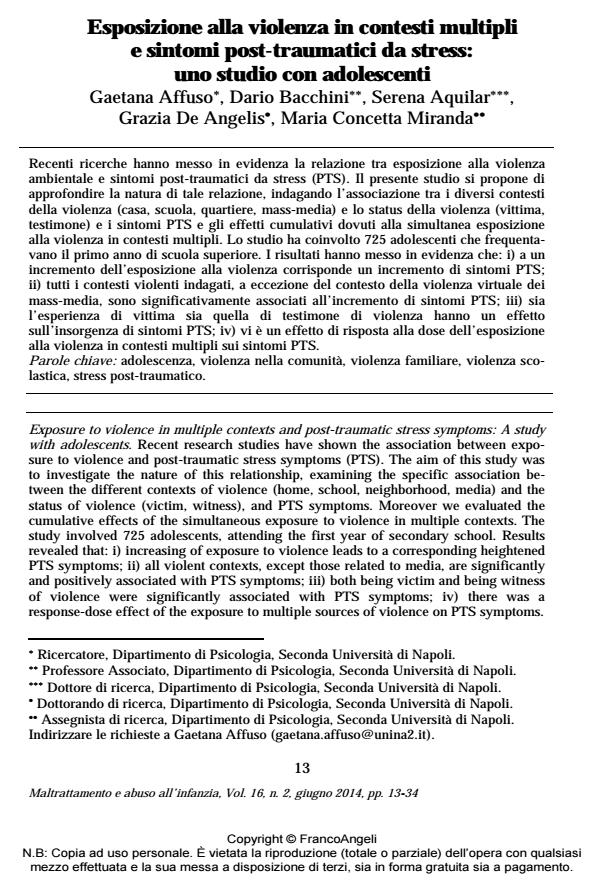Esposizione alla violenza in contesti multipli e sintomi post-traumatici da stress: uno studio con adolescenti
Titolo Rivista MALTRATTAMENTO E ABUSO ALL’INFANZIA
Autori/Curatori Gaetana Affuso, Dario Bacchini, Serena Aquilar, Grazia De Angelis, Maria Concetta Miranda
Anno di pubblicazione 2014 Fascicolo 2014/2
Lingua Italiano Numero pagine 21 P. 13-33 Dimensione file 115 KB
DOI 10.3280/MAL2014-002002
Il DOI è il codice a barre della proprietà intellettuale: per saperne di più
clicca qui
Qui sotto puoi vedere in anteprima la prima pagina di questo articolo.
Se questo articolo ti interessa, lo puoi acquistare (e scaricare in formato pdf) seguendo le facili indicazioni per acquistare il download credit. Acquista Download Credits per scaricare questo Articolo in formato PDF

FrancoAngeli è membro della Publishers International Linking Association, Inc (PILA)associazione indipendente e non profit per facilitare (attraverso i servizi tecnologici implementati da CrossRef.org) l’accesso degli studiosi ai contenuti digitali nelle pubblicazioni professionali e scientifiche
Recenti ricerche hanno messo in evidenza la relazione tra esposizione alla violenza ambientale e sintomi post-traumatici da stress (PTS). Il presente studio si propone di approfondire la natura di tale relazione, indagando l’associazione tra i diversi contesti della violenza (casa, scuola, quartiere, mass-media) e lo status della violenza (vittima, testimone) e i sintomi PTS e gli effetti cumulativi dovuti alla simultanea esposizione alla violenza in contesti multipli. Lo studio ha coinvolto 725 adolescenti che frequentavano il primo anno di scuola superiore. I risultati hanno messo in evidenza che: i) a un incremento dell’esposizione alla violenza corrisponde un incremento di sintomi PTS; ii) tutti i contesti violenti indagati, a eccezione del contesto della violenza virtuale dei mass-media, sono significativamente associati all’incremento di sintomi PTS; iii) sia l’esperienza di vittima sia quella di testimone di violenza hanno un effetto sull’insorgenza di sintomi PTS; iv) vi è un effetto di risposta alla dose dell’esposizione alla violenza in contesti multipli sui sintomi PTS.
Parole chiave:Adolescenza, violenza nella comunità, violenza familiare, violenza scolastica, stress post-traumatico
- Attaccamento e bullismo: un confronto tra bulli, vittime, bulli-vittime e non-coinvolti in età scolare Lorenza Di Pentima, Sara Ramelli, in MALTRATTAMENTO E ABUSO ALL'INFANZIA 2/2020 pp.119
DOI: 10.3280/MAL2020-002007 - The Cambridge Handbook of Community Psychology pp.197 (ISBN:9781108678971)
- Children and Peace Dario Bacchini, Concetta Esposito, pp.157 (ISBN:978-3-030-22175-1)
- The Cambridge Handbook of Community Psychology Christopher M. Thompson, Corinne C. Datchi, Lakeesha Eure, pp.289 (ISBN:9781108678971)
- The Cambridge Handbook of Community Psychology Caroline S. Clauss-Ehlers, (ISBN:9781108678971)
Gaetana Affuso, Dario Bacchini, Serena Aquilar, Grazia De Angelis, Maria Concetta Miranda, Esposizione alla violenza in contesti multipli e sintomi post-traumatici da stress: uno studio con adolescenti in "MALTRATTAMENTO E ABUSO ALL’INFANZIA" 2/2014, pp 13-33, DOI: 10.3280/MAL2014-002002